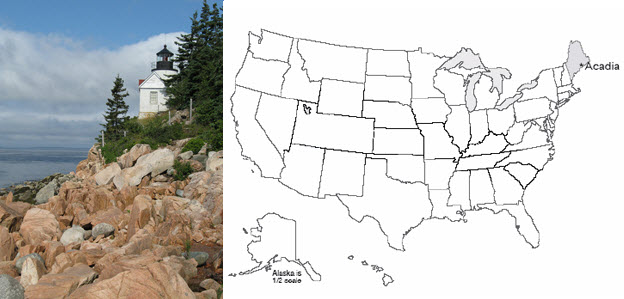Acadia National Park and Sea-Level Rise

The subduction and collision with Europe during the closing of the proto-Atlantic made great granite bodies draped in metamorphosed rocks that started as sediments. Erosion over long times has exposed these rocks that once were deep in the mountain range, and we find them at the surface in places including along the Maine coast. The ice-age glaciers scoured those rocks and left the beautiful, bald mountain tops of what is now Acadia National Park, staring out at the storm-tossed North Atlantic across Somes Sound, the only fjord on the east coast of the U.S.
The Wabanaki tribe of Native Americans probably reversed the modern tourist pattern, summering inland and then moving to the relatively more moderate coast of Acadia in the winter. Nasty winter storms do run up the coast, but the wintertime temperatures plunge far lower inland than they do on the coast. Thick piles of discarded shells from nutritious sea creatures dating back 6000 years attest to the importance of the sea to these early people.
On September 5, 1604, the French explorer Samuel de Champlain landed on Acadia’s island. Impressed by the bare, rocky, deserted appearance of the glacially scoured granite mountain peaks of the island, he named it Isles de Monts Desert, “Island of the Bare Mountains.”
French influence was important until the end of the French and Indian War, after which English and then U.S. activity came to dominate. In the mid-1800s, Mount Desert Island attracted the art world, and was featured in paintings by many artists including Frederic Church, Thomas Cole, and others of the Hudson River School. For example, see Sanford Robinson Gifford’s "The Artist Sketching at Mount Desert, Maine, 1864-1865", now in the National Gallery of Art and reproduced just below.

The artists, in turn, attracted the “rusticators,” tourists who gradually were replaced by much wealthier tourists who built summer “cottages”—the Rockefellers, Fords, Vanderbilts, Carnegies, etc. These wealthy patrons in turn invested resources and political capital in preserving most of the island as a national park.
Today, over 4 million visitors per year flock to Mount Desert Island, with most of them getting out of the gift shops and into the national park. The visitors enjoy the history, the beauty, the rather chilly ocean waters (based on personal observation by the author, even on hot summer days, more people are sitting by the sea than swimming in it!), the outstanding network of paths for bicycling, superb kayaking on lakes and sea, and much more.